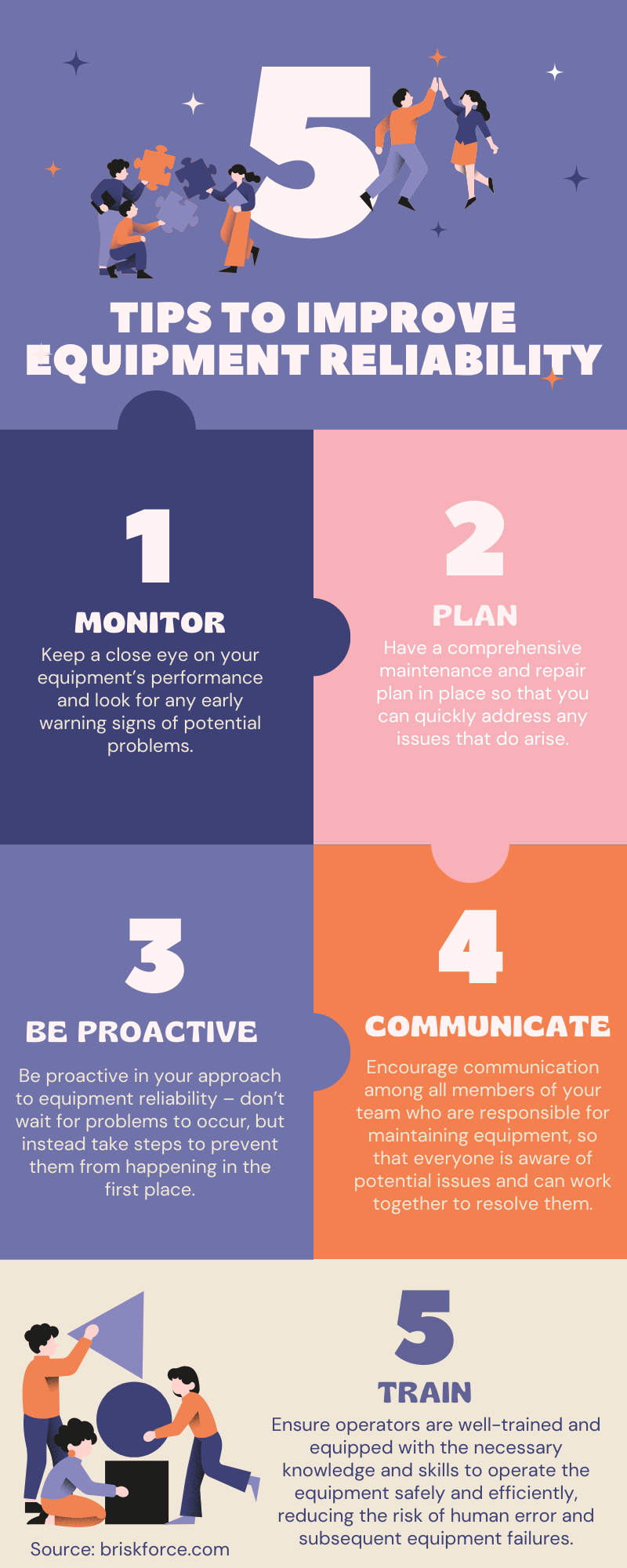How to Improve Equipment Reliability? Best Practices & Tips
Uncover the best practices to improve equipment reliability, prevent downtime and revolutionize your maintenance processes.

Welcome to our blog post on improving equipment reliability, where we uncover the best practices and share valuable tips that will revolutionize your maintenance processes. In today’s fast-paced world, businesses cannot afford unexpected breakdowns or costly downtime. Whether you’re a small-scale operation or an industry giant, enhancing equipment reliability is crucial for increasing productivity and maximizing profits. Join us as we dive into proven strategies and expert advice that will empower you to ensure smooth operations and prevent downtime.
Introduction to Equipment Reliability
Equipment reliability refers to the ability of machinery, systems, or devices to perform their intended functions consistently and predictably over a specified period. It is a measure of the equipment’s dependability and the extent to which it can operate without failures or breakdowns. Equipment reliability encompasses various factors such as uptime, availability, durability, maintainability, and overall performance. It involves ensuring that equipment operates within specified parameters, meets performance requirements, and minimizes the risk of unexpected failures or malfunctions. Achieving high equipment reliability involves implementing effective maintenance strategies, utilizing quality components, following proper operating procedures, conducting risk assessments, and continuously monitoring performance. By improving equipment reliability, organizations can enhance productivity, reduce downtime, optimize resources, and achieve higher levels of operational efficiency.
Factors that Affect Equipment Reliability
Many factors affect equipment reliability. Some of these are within your control, while others are out of your hands. Here are some of the most important factors to keep in mind:
1. Operating conditions
The conditions under which your equipment is operated can have a big impact on its reliability. Make sure you understand the limits of your equipment and operate it within those limits.
2. Maintenance
Proper maintenance is essential for keeping equipment reliable. Be sure to follow the manufacturer’s recommended maintenance schedule and procedures.
3. Quality
The quality of the equipment itself can have a big impact on its reliability. Make sure you buy from a reputable manufacturer and that the equipment meets all relevant safety standards.
These are just a few of the factors that can affect equipment reliability. By understanding all of these factors, you can put yourself in the best position to keep your equipment running reliably for years to come.
Best Practices for Improving Equipment Reliability
When it comes to improving equipment reliability, there are several best practices that organizations can follow. Here are some of the most effective:
1. Invest in Regular Preventive Maintenance
Preventive maintenance plays a crucial role in enhancing equipment reliability by proactively addressing potential issues before they escalate into major problems. By adhering to a regular maintenance schedule, organizations can ensure that their equipment is operating at optimal levels, minimizing the risk of unexpected breakdowns and downtime. This proactive approach involves tasks such as routine inspections, cleaning, lubrication, and component replacements, all aimed at identifying and rectifying minor faults or wear and tear before they cause significant damage. Through preventive maintenance, equipment operators can detect and resolve potential issues early, preserving the integrity and longevity of the equipment. This not only increases reliability but also reduces the likelihood of costly repairs, extends the lifespan of the equipment, and improves overall operational efficiency. By investing in preventive maintenance, organizations can effectively minimize unplanned downtime, maximize productivity, and ultimately achieve greater profitability.
2. Use High-Quality Parts and Materials
Utilizing high-quality parts and materials can significantly enhance equipment reliability by ensuring superior performance, durability, and longevity. When inferior or substandard components are used, they are more prone to failure, leading to frequent breakdowns and reduced overall reliability. On the other hand, high-quality parts and materials are designed to meet stringent standards, offering enhanced resistance to wear and tear, improved functionality, and increased reliability.
For example, let’s consider an industrial manufacturing plant that relies on conveyor belts for the smooth transportation of materials throughout the production process. By investing in high-quality conveyor belts made from durable materials such as reinforced rubber or steel cords, the plant can expect increased reliability and minimized downtime. These robust belts can withstand the daily rigors of heavy loads, abrasion, and harsh environmental conditions, reducing the chances of premature failure.
Furthermore, high-quality components, such as bearings or motors, within the conveyor system, can greatly impact reliability. Opting for well-manufactured bearings with superior load-bearing capacities and advanced lubrication properties ensures smoother operation, reduced friction, and extended lifespan. Similarly, high-quality motors with reliable insulation, efficient cooling mechanisms, and accurate power delivery can minimize the risk of overheating, motor failures, and unexpected downtime.
3. Implement Operational Procedures
Implementing operation procedures can significantly improve equipment reliability by providing standardized guidelines and best practices for equipment operation and maintenance. These procedures ensure consistency, efficiency, and safety in handling equipment, reducing the likelihood of human error and equipment failures.
Firstly, operation procedures outline proper start-up and shutdown protocols, ensuring that equipment is operated within its designated operating parameters. By following established procedures, operators can avoid unnecessary stress on the equipment, such as abrupt temperature changes or excessive load variations, which can lead to premature wear and failures.
Secondly, operation procedures include regular inspection and maintenance tasks. These tasks can range from simple visual checks to more comprehensive procedures, depending on the equipment type. By performing routine inspections and adhering to maintenance schedules, operators can identify potential issues early on, such as leaks, loose connections, or abnormal vibrations. Addressing these issues promptly through proactive maintenance helps prevent larger problems and enhances equipment reliability.
Additionally, operation procedures often include guidelines for proper equipment usage, such as load limits, recommended operating speeds, and environmental considerations. Adhering to these guidelines ensures that the equipment operates within its design specifications, reducing the risk of overloading, overheating, or other operational stresses that can lead to failures.
Furthermore, operation procedures can outline correct storage and handling practices for equipment during non-operational periods. This includes guidelines for proper cleaning, lubrication, and protection from environmental factors such as moisture or corrosive substances. By storing and handling equipment appropriately, operators can prevent degradation and maintain its reliability over time.
4. Conduct Risk Assessments
Conducting risk assessments can significantly improve equipment dependability by identifying potential hazards, vulnerabilities, and failure points associated with equipment operation. Risk assessments involve a systematic evaluation of various factors, including equipment design, operational processes, environmental conditions, and human factors. By understanding and mitigating these risks, organizations can enhance equipment dependability in several ways.
Firstly, risk assessments help identify and prioritize critical risks that can affect equipment dependability. By analyzing potential failure modes and their associated consequences, organizations can allocate resources effectively to address the most significant risks. This allows them to implement targeted measures, such as redundancy systems, backup power supplies, or enhanced maintenance procedures, to mitigate identified risks and improve equipment dependability.
Secondly, risk assessments highlight potential weaknesses in equipment design or manufacturing. By examining factors like material quality, component compatibility, and structural integrity, organizations can identify areas where improvements or modifications are needed. Addressing design flaws or using higher-quality materials during equipment procurement and development can enhance reliability and minimize the risk of unexpected failures.
Furthermore, risk assessments help identify operational risks and develop appropriate strategies to mitigate them. This includes evaluating operator training needs, establishing clear operating procedures, and implementing safety protocols. By ensuring operators are well-trained and equipped with the necessary knowledge and skills to operate the equipment safely and efficiently, the risk of human error and subsequent equipment failures can be reduced.
Risk assessments also consider environmental factors that may impact equipment dependability, such as temperature variations, humidity, or exposure to corrosive substances. By understanding these environmental risks, organizations can implement protective measures, such as proper insulation, ventilation systems, or corrosion-resistant coatings, to mitigate the negative effects and enhance equipment dependability.
Moreover, conducting regular risk assessments allows organizations to continuously monitor and adapt to evolving risks. As equipment ages or operational conditions change, new risks may emerge. By periodically reassessing and updating risk assessments, organizations can proactively identify and mitigate these emerging risks, ensuring ongoing equipment dependability.

Benefits of Improved Equipment Reliability
Equipment reliability is a major concern for businesses. Downtime can lead to lost production, revenue, and customers. Improved equipment reliability can help businesses avoid these losses.
There are many benefits of improved equipment reliability. Perhaps the most obvious benefit is that businesses can avoid the losses associated with downtime. When equipment is down, production stops and revenues are lost. In some cases, customers may go to competitors if they cannot get the products or services they need from your business. By improving equipment reliability, businesses can avoid these losses and keep their operations running smoothly.
Improved equipment reliability can also lead to increased efficiency and productivity. When equipment is reliable, it runs smoothly and without interruption. This can help businesses save time and money by reducing the need for repairs or replacements. Additionally, well-functioning equipment can help employees work more efficiently and effectively, leading to increased productivity.
Improved equipment reliability provides numerous benefits for businesses. By avoiding downtime and increasing efficiency and productivity, businesses can improve their bottom line and keep their operations running smoothly.
Conclusion
Improving the reliability of your equipment is essential to ensuring a successful business operation. Utilizing best practices and tips like preventive maintenance, regular inspections, quality control checks, and investing in high-quality spares can help you keep your equipment running efficiently for years to come. Investing in reliable equipment sets you up for success and guarantees that your operations remain productive with minimal interruptions due to breakdowns or malfunctions. With these tips and strategies, you’re sure to improve the reliability of all of your work equipment.